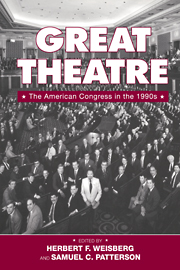Book contents
- Frontmatter
- Contents
- Figures and Tables
- Preface
- Contributors
- Introduction
- Congress and Its Audience
- Congress at Play
- Congress and Other Actors
- 8 The Plot Thickens: Congress and the President
- 9 Congress and the Courts: A Case of Casting
- 10 Behind the Scenes: The Supreme Court and Congress in Statutory Interpretation
- 11 Congress and Foreign Policy: A Neglected Stage
- Conclusion
- References
- Index
10 - Behind the Scenes: The Supreme Court and Congress in Statutory Interpretation
Published online by Cambridge University Press: 20 January 2010
- Frontmatter
- Contents
- Figures and Tables
- Preface
- Contributors
- Introduction
- Congress and Its Audience
- Congress at Play
- Congress and Other Actors
- 8 The Plot Thickens: Congress and the President
- 9 Congress and the Courts: A Case of Casting
- 10 Behind the Scenes: The Supreme Court and Congress in Statutory Interpretation
- 11 Congress and Foreign Policy: A Neglected Stage
- Conclusion
- References
- Index
Summary
Interaction between the Supreme Court and Congress often involves high drama – occasionally melodrama. Indeed, the Court's constitutional decisions have served as a catalyst for some of the most compelling theatre in Congress. The Court's decisions on issues such as abortion and flag burning have led to long and emotional legislative debates. The Senate hearings on the Court nominations of Robert Bork and Clarence Thomas, both of whom garnered ardent support and intense opposition because of their views on constitutional issues, challenged the “soaps” for popular viewing interest.
But the relationship between Court and Congress sometimes takes place behind the scenes. That is the case most often with statutory interpretation. A large proportion of the Supreme Court's decisions – a substantial majority in the 1990s – involve interpretation of federal statutes rather than constitutional issues. In the statutory arena, the Court addresses such matters as the rules for criminal sentencing in federal court and the scope of federal laws that prohibit monopolistic practices. These statutory decisions seldom attract widespread attention, but this part of the Court's work has far-reaching implications. The Court's resolution of disputes over the meaning of statutory provisions has a major impact on federal policy and national life in such important areas as civil rights, environmental protection, and labor-management relations.
Once the Supreme Court interprets a statutory provision, its interpretation is authoritative: lower courts and administrative agencies must follow the Court's lead. But Congress is free to override the Court's decision simply by enacting a new statute. If a sufficient number of members disagree with the Court's interpretation, they can write into the law new language that precludes such an interpretation.
- Type
- Chapter
- Information
- Great TheatreThe American Congress in the 1990s, pp. 224 - 247Publisher: Cambridge University PressPrint publication year: 1998
- 5
- Cited by



